Comparative Analysis: Change Agents at QBE and Allianz Insurance
VerifiedAdded on 2021/12/17
|16
|1204
|80
Report
AI Summary
This report provides a comparative analysis of change agents and their impact on QBE and Allianz Insurance. It examines the roles of change agents in initiating and managing change within these organizations, focusing on leadership styles, HR transformations, and offshoring strategies. The analysis explores the episodic and transformational approaches to change, highlighting key initiatives such as the appointment of new leadership at QBE and the implementation of an idea management platform at Allianz. The report also discusses the challenges and successes of these change initiatives, including cultural concerns related to offshoring and the importance of employee engagement in driving innovation. The conclusion summarizes the key arguments and points, offering insights into how these companies have adapted to various challenges through effective change management.
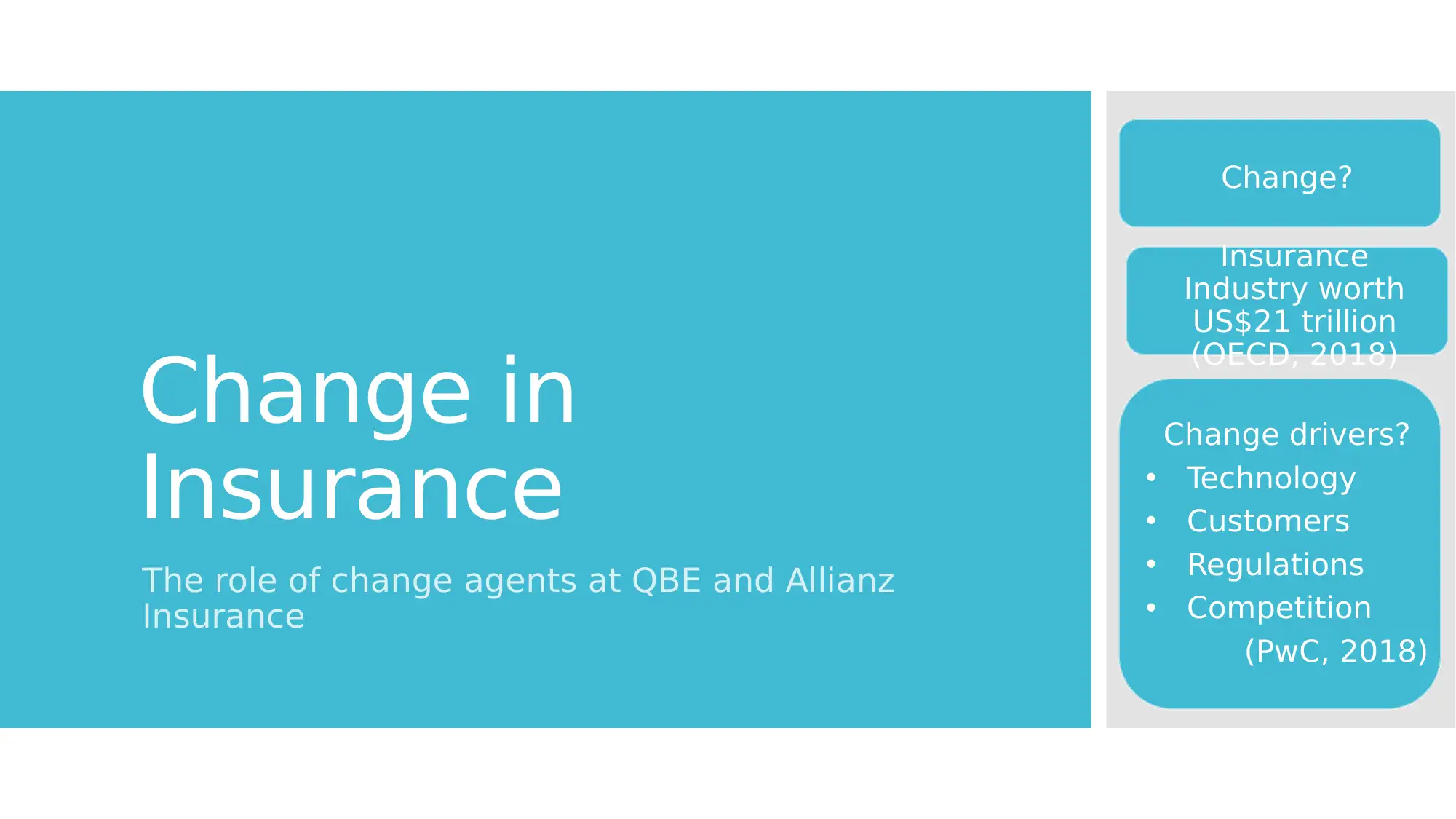
Change in
Insurance
The role of change agents at QBE and Allianz
Insurance
Change?
Change drivers?
• Technology
• Customers
• Regulations
• Competition
(PwC, 2018)
Insurance
Industry worth
US$21 trillion
(OECD, 2018)
Insurance
The role of change agents at QBE and Allianz
Insurance
Change?
Change drivers?
• Technology
• Customers
• Regulations
• Competition
(PwC, 2018)
Insurance
Industry worth
US$21 trillion
(OECD, 2018)
Paraphrase This Document
Need a fresh take? Get an instant paraphrase of this document with our AI Paraphraser
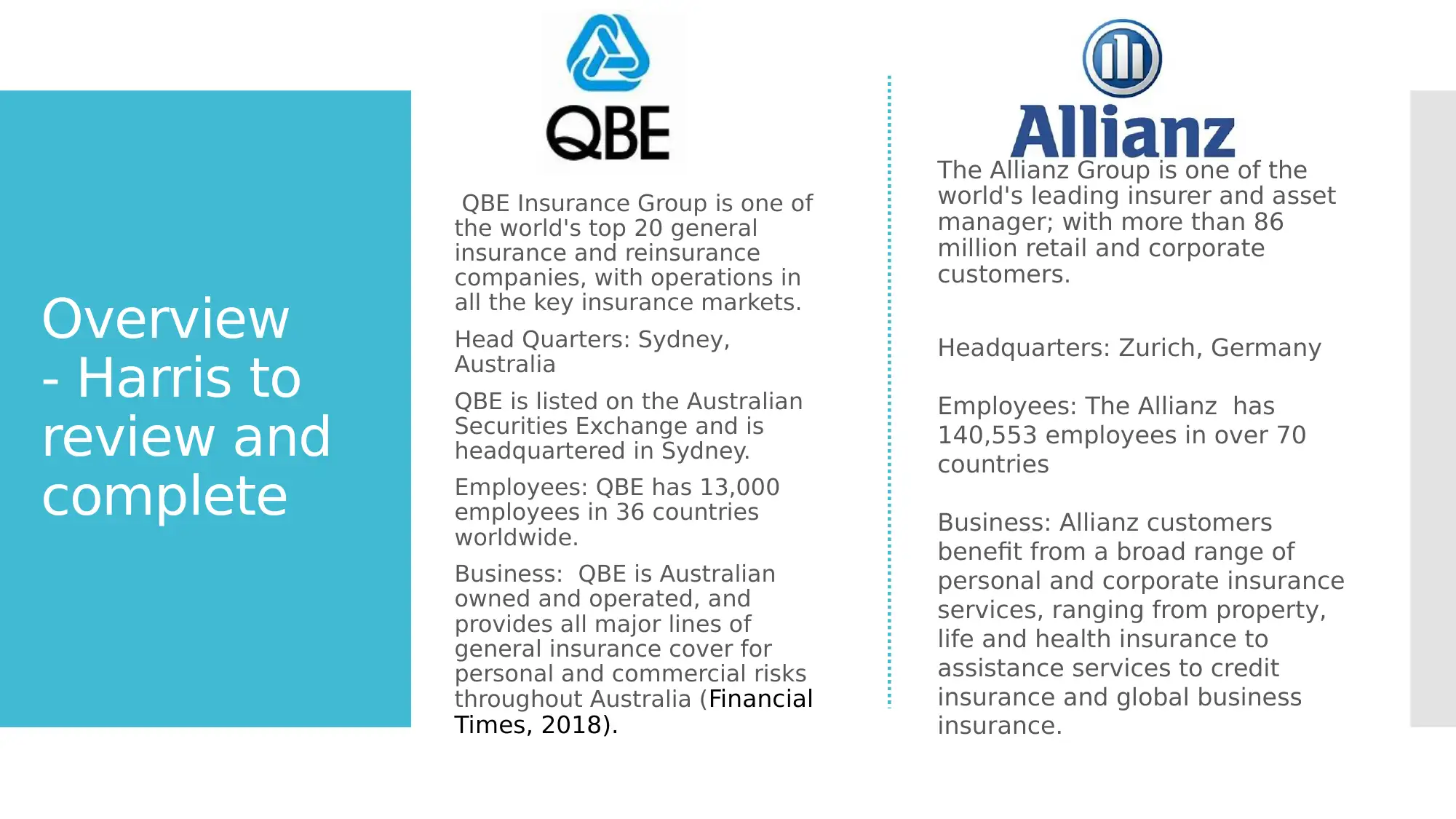
Overview
- Harris to
review and
complete
QBE Insurance Group is one of
the world's top 20 general
insurance and reinsurance
companies, with operations in
all the key insurance markets.
Head Quarters: Sydney,
Australia
QBE is listed on the Australian
Securities Exchange and is
headquartered in Sydney.
Employees: QBE has 13,000
employees in 36 countries
worldwide.
Business: QBE is Australian
owned and operated, and
provides all major lines of
general insurance cover for
personal and commercial risks
throughout Australia (Financial
Times, 2018).
The Allianz Group is one of the
world's leading insurer and asset
manager; with more than 86
million retail and corporate
customers.
Headquarters: Zurich, Germany
Employees: The Allianz has
140,553 employees in over 70
countries
Business: Allianz customers
benefit from a broad range of
personal and corporate insurance
services, ranging from property,
life and health insurance to
assistance services to credit
insurance and global business
insurance.
- Harris to
review and
complete
QBE Insurance Group is one of
the world's top 20 general
insurance and reinsurance
companies, with operations in
all the key insurance markets.
Head Quarters: Sydney,
Australia
QBE is listed on the Australian
Securities Exchange and is
headquartered in Sydney.
Employees: QBE has 13,000
employees in 36 countries
worldwide.
Business: QBE is Australian
owned and operated, and
provides all major lines of
general insurance cover for
personal and commercial risks
throughout Australia (Financial
Times, 2018).
The Allianz Group is one of the
world's leading insurer and asset
manager; with more than 86
million retail and corporate
customers.
Headquarters: Zurich, Germany
Employees: The Allianz has
140,553 employees in over 70
countries
Business: Allianz customers
benefit from a broad range of
personal and corporate insurance
services, ranging from property,
life and health insurance to
assistance services to credit
insurance and global business
insurance.
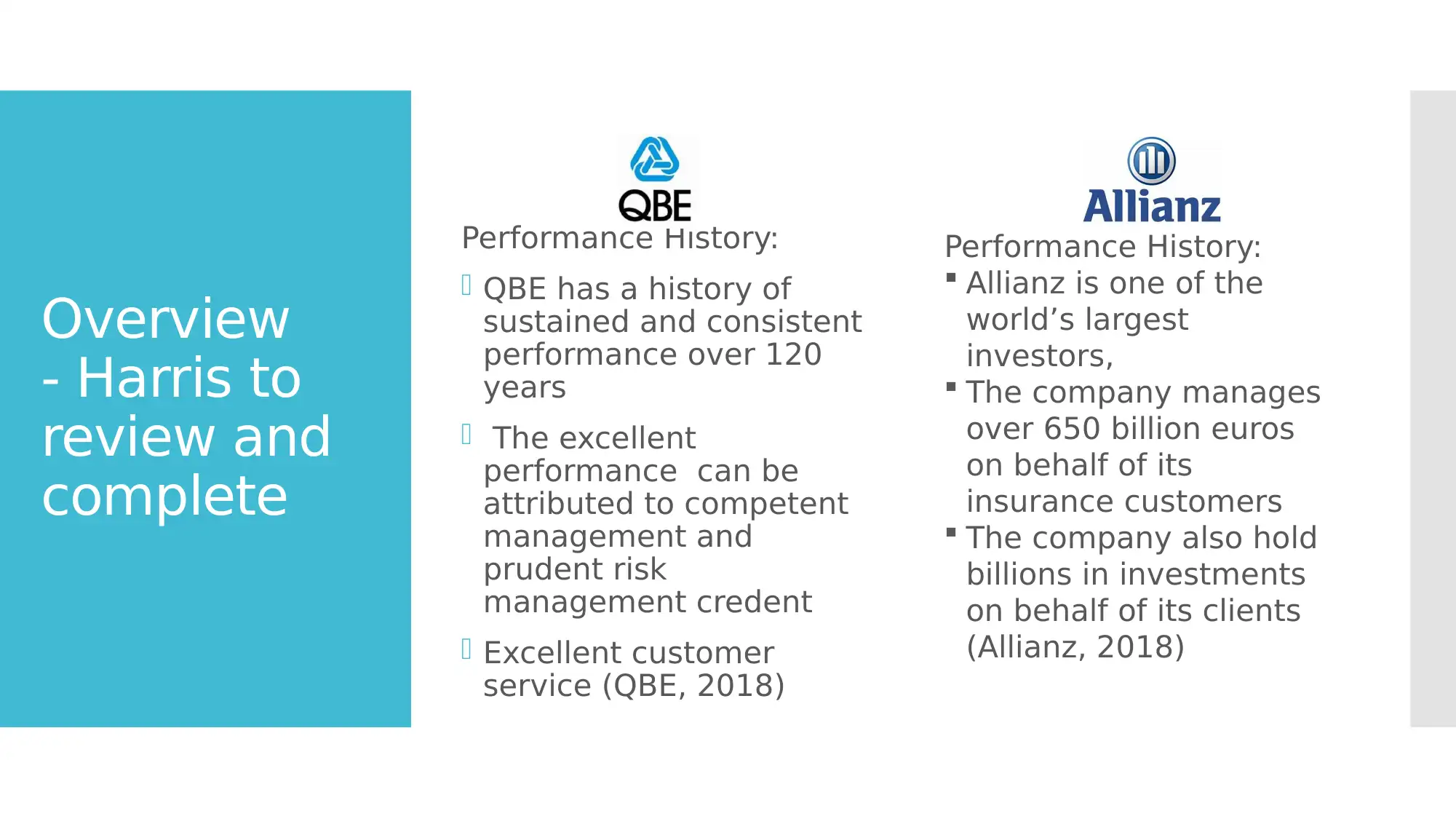
Overview
- Harris to
review and
complete
Performance History:
QBE has a history of
sustained and consistent
performance over 120
years
The excellent
performance can be
attributed to competent
management and
prudent risk
management credent
Excellent customer
service (QBE, 2018)
Performance History:
Allianz is one of the
world’s largest
investors,
The company manages
over 650 billion euros
on behalf of its
insurance customers
The company also hold
billions in investments
on behalf of its clients
(Allianz, 2018)
- Harris to
review and
complete
Performance History:
QBE has a history of
sustained and consistent
performance over 120
years
The excellent
performance can be
attributed to competent
management and
prudent risk
management credent
Excellent customer
service (QBE, 2018)
Performance History:
Allianz is one of the
world’s largest
investors,
The company manages
over 650 billion euros
on behalf of its
insurance customers
The company also hold
billions in investments
on behalf of its clients
(Allianz, 2018)
⊘ This is a preview!⊘
Do you want full access?
Subscribe today to unlock all pages.

Trusted by 1+ million students worldwide
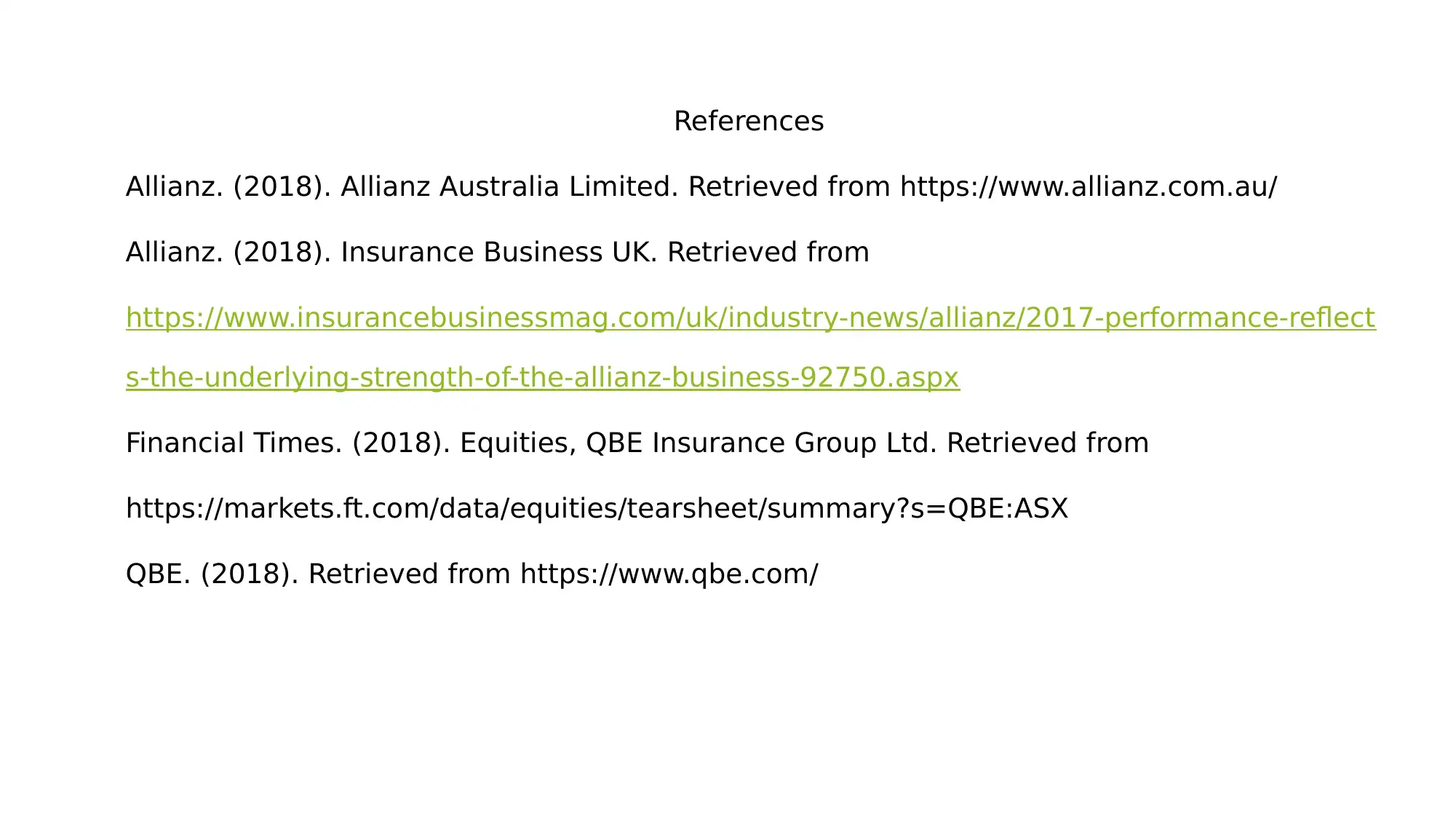
References
Allianz. (2018). Allianz Australia Limited. Retrieved from https://www.allianz.com.au/
Allianz. (2018). Insurance Business UK. Retrieved from
https://www.insurancebusinessmag.com/uk/industry-news/allianz/2017-performance-reflect
s-the-underlying-strength-of-the-allianz-business-92750.aspx
Financial Times. (2018). Equities, QBE Insurance Group Ltd. Retrieved from
https://markets.ft.com/data/equities/tearsheet/summary?s=QBE:ASX
QBE. (2018). Retrieved from https://www.qbe.com/
Allianz. (2018). Allianz Australia Limited. Retrieved from https://www.allianz.com.au/
Allianz. (2018). Insurance Business UK. Retrieved from
https://www.insurancebusinessmag.com/uk/industry-news/allianz/2017-performance-reflect
s-the-underlying-strength-of-the-allianz-business-92750.aspx
Financial Times. (2018). Equities, QBE Insurance Group Ltd. Retrieved from
https://markets.ft.com/data/equities/tearsheet/summary?s=QBE:ASX
QBE. (2018). Retrieved from https://www.qbe.com/
Paraphrase This Document
Need a fresh take? Get an instant paraphrase of this document with our AI Paraphraser
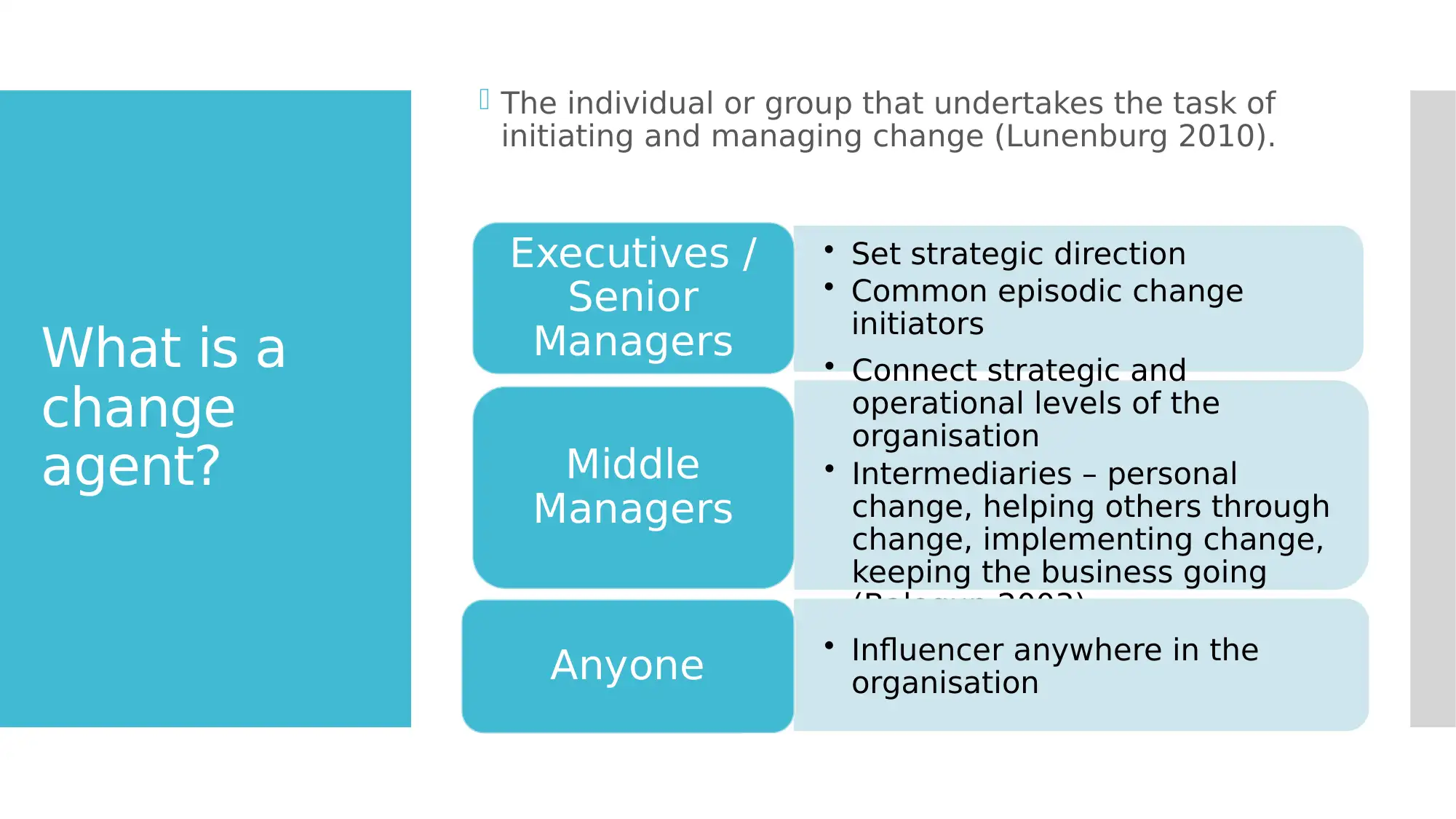
What is a
change
agent?
The individual or group that undertakes the task of
initiating and managing change (Lunenburg 2010).
• Set strategic direction
• Common episodic change
initiators
Executives /
Senior
Managers • Connect strategic and
operational levels of the
organisation
• Intermediaries – personal
change, helping others through
change, implementing change,
keeping the business going
(Balogun 2003)
Middle
Managers
• Influencer anywhere in the
organisationAnyone
change
agent?
The individual or group that undertakes the task of
initiating and managing change (Lunenburg 2010).
• Set strategic direction
• Common episodic change
initiators
Executives /
Senior
Managers • Connect strategic and
operational levels of the
organisation
• Intermediaries – personal
change, helping others through
change, implementing change,
keeping the business going
(Balogun 2003)
Middle
Managers
• Influencer anywhere in the
organisationAnyone
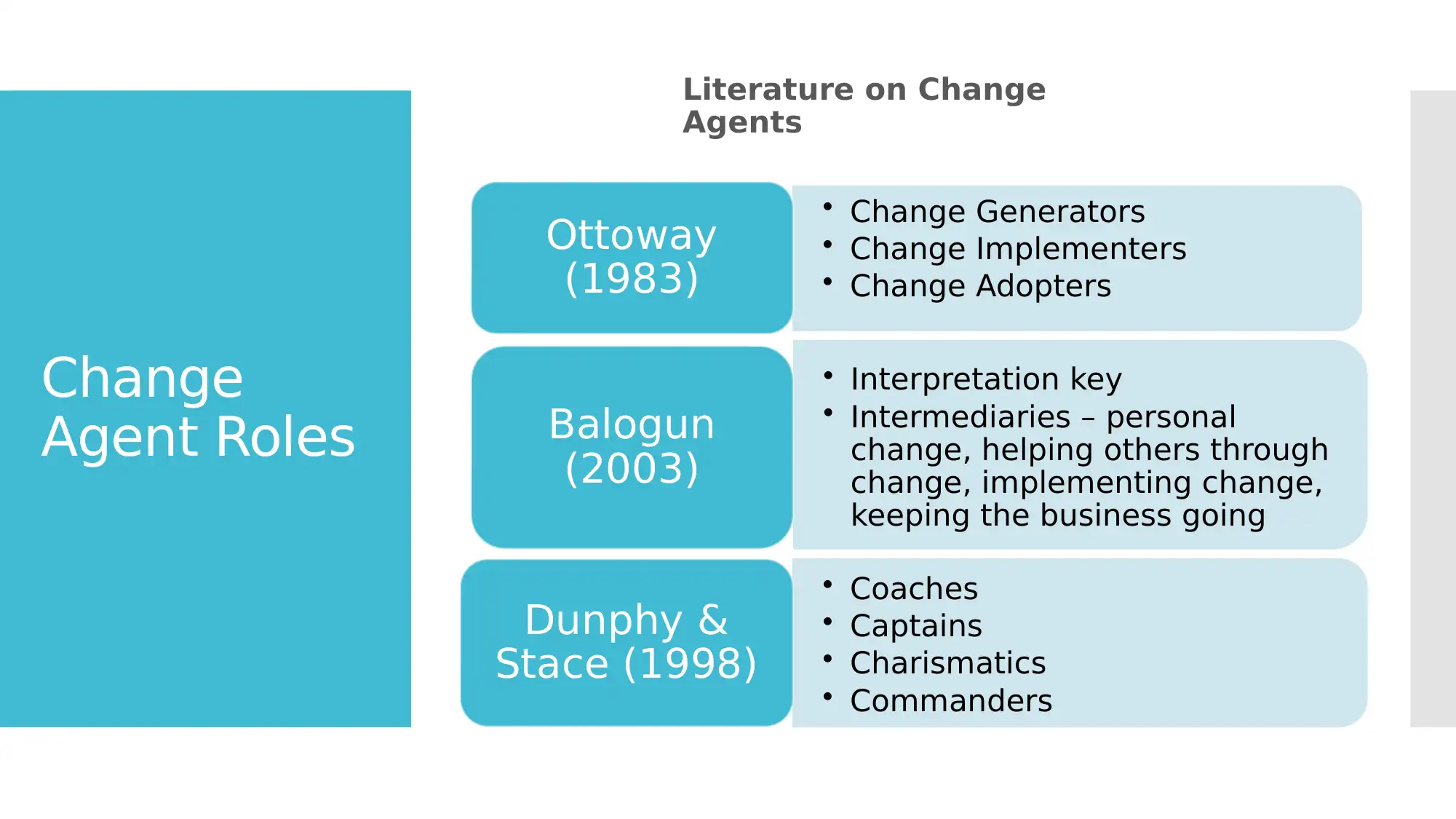
Change
Agent Roles
Literature on Change
Agents
• Change Generators
• Change Implementers
• Change Adopters
Ottoway
(1983)
• Interpretation key
• Intermediaries – personal
change, helping others through
change, implementing change,
keeping the business going
Balogun
(2003)
• Coaches
• Captains
• Charismatics
• Commanders
Dunphy &
Stace (1998)
Agent Roles
Literature on Change
Agents
• Change Generators
• Change Implementers
• Change Adopters
Ottoway
(1983)
• Interpretation key
• Intermediaries – personal
change, helping others through
change, implementing change,
keeping the business going
Balogun
(2003)
• Coaches
• Captains
• Charismatics
• Commanders
Dunphy &
Stace (1998)
⊘ This is a preview!⊘
Do you want full access?
Subscribe today to unlock all pages.

Trusted by 1+ million students worldwide
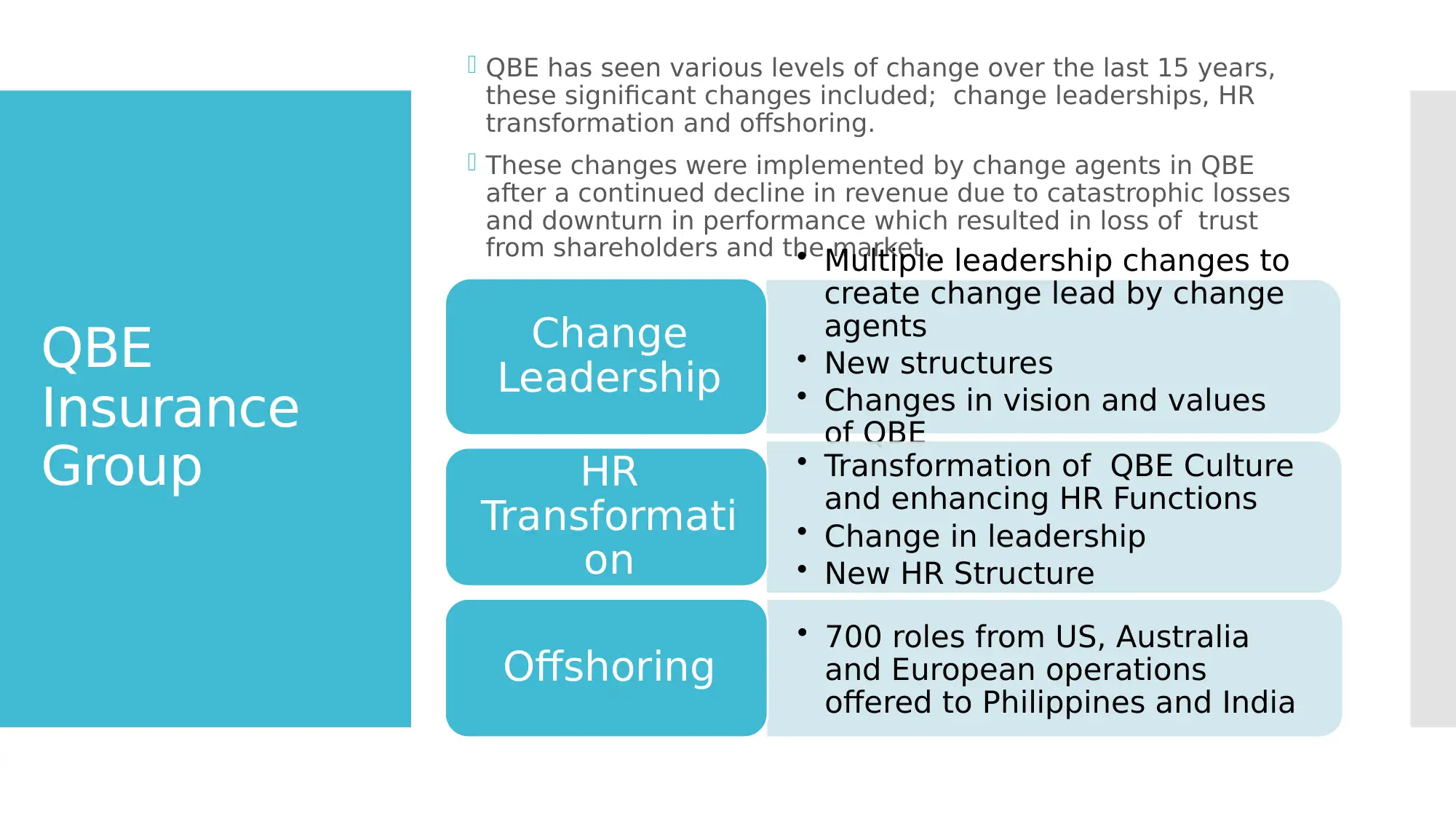
QBE
Insurance
Group
QBE has seen various levels of change over the last 15 years,
these significant changes included; change leaderships, HR
transformation and offshoring.
These changes were implemented by change agents in QBE
after a continued decline in revenue due to catastrophic losses
and downturn in performance which resulted in loss of trust
from shareholders and the market.• Multiple leadership changes to
create change lead by change
agents
• New structures
• Changes in vision and values
of QBE
Change
Leadership
• Transformation of QBE Culture
and enhancing HR Functions
• Change in leadership
• New HR Structure
HR
Transformati
on
• 700 roles from US, Australia
and European operations
offered to Philippines and India
Offshoring
Insurance
Group
QBE has seen various levels of change over the last 15 years,
these significant changes included; change leaderships, HR
transformation and offshoring.
These changes were implemented by change agents in QBE
after a continued decline in revenue due to catastrophic losses
and downturn in performance which resulted in loss of trust
from shareholders and the market.• Multiple leadership changes to
create change lead by change
agents
• New structures
• Changes in vision and values
of QBE
Change
Leadership
• Transformation of QBE Culture
and enhancing HR Functions
• Change in leadership
• New HR Structure
HR
Transformati
on
• 700 roles from US, Australia
and European operations
offered to Philippines and India
Offshoring
Paraphrase This Document
Need a fresh take? Get an instant paraphrase of this document with our AI Paraphraser
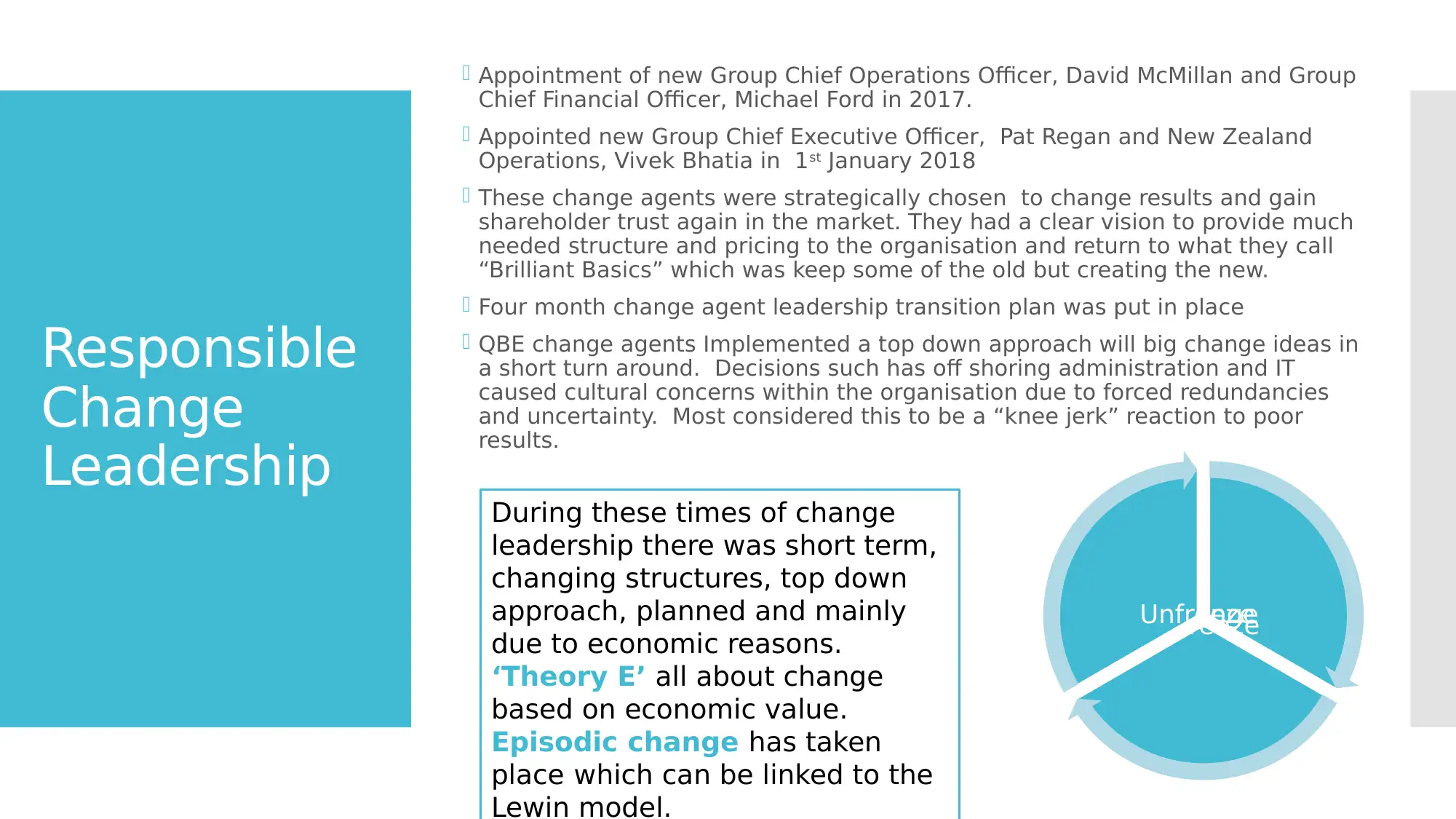
Responsible
Change
Leadership
Appointment of new Group Chief Operations Officer, David McMillan and Group
Chief Financial Officer, Michael Ford in 2017.
Appointed new Group Chief Executive Officer, Pat Regan and New Zealand
Operations, Vivek Bhatia in 1st January 2018
These change agents were strategically chosen to change results and gain
shareholder trust again in the market. They had a clear vision to provide much
needed structure and pricing to the organisation and return to what they call
“Brilliant Basics” which was keep some of the old but creating the new.
Four month change agent leadership transition plan was put in place
QBE change agents Implemented a top down approach will big change ideas in
a short turn around. Decisions such has off shoring administration and IT
caused cultural concerns within the organisation due to forced redundancies
and uncertainty. Most considered this to be a “knee jerk” reaction to poor
results.
ChangeRefreezeUnfreeze
During these times of change
leadership there was short term,
changing structures, top down
approach, planned and mainly
due to economic reasons.
‘Theory E’ all about change
based on economic value.
Episodic change has taken
place which can be linked to the
Lewin model.
Change
Leadership
Appointment of new Group Chief Operations Officer, David McMillan and Group
Chief Financial Officer, Michael Ford in 2017.
Appointed new Group Chief Executive Officer, Pat Regan and New Zealand
Operations, Vivek Bhatia in 1st January 2018
These change agents were strategically chosen to change results and gain
shareholder trust again in the market. They had a clear vision to provide much
needed structure and pricing to the organisation and return to what they call
“Brilliant Basics” which was keep some of the old but creating the new.
Four month change agent leadership transition plan was put in place
QBE change agents Implemented a top down approach will big change ideas in
a short turn around. Decisions such has off shoring administration and IT
caused cultural concerns within the organisation due to forced redundancies
and uncertainty. Most considered this to be a “knee jerk” reaction to poor
results.
ChangeRefreezeUnfreeze
During these times of change
leadership there was short term,
changing structures, top down
approach, planned and mainly
due to economic reasons.
‘Theory E’ all about change
based on economic value.
Episodic change has taken
place which can be linked to the
Lewin model.
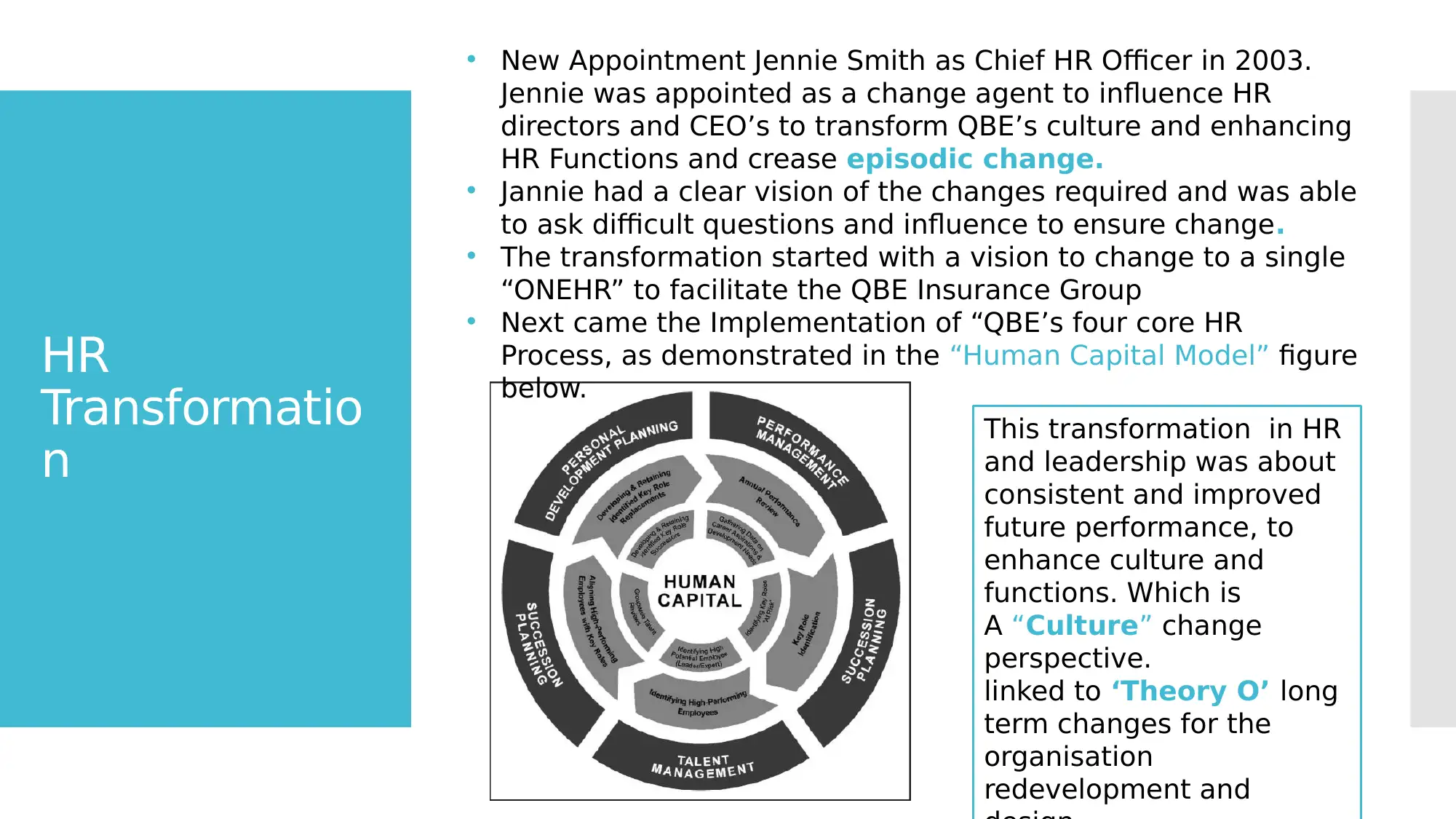
HR
Transformatio
n
• New Appointment Jennie Smith as Chief HR Officer in 2003.
Jennie was appointed as a change agent to influence HR
directors and CEO’s to transform QBE’s culture and enhancing
HR Functions and crease episodic change.
• Jannie had a clear vision of the changes required and was able
to ask difficult questions and influence to ensure change.
• The transformation started with a vision to change to a single
“ONEHR” to facilitate the QBE Insurance Group
• Next came the Implementation of “QBE’s four core HR
Process, as demonstrated in the “Human Capital Model” figure
below.
This transformation in HR
and leadership was about
consistent and improved
future performance, to
enhance culture and
functions. Which is
A “Culture” change
perspective.
linked to ‘Theory O’ long
term changes for the
organisation
redevelopment and
Transformatio
n
• New Appointment Jennie Smith as Chief HR Officer in 2003.
Jennie was appointed as a change agent to influence HR
directors and CEO’s to transform QBE’s culture and enhancing
HR Functions and crease episodic change.
• Jannie had a clear vision of the changes required and was able
to ask difficult questions and influence to ensure change.
• The transformation started with a vision to change to a single
“ONEHR” to facilitate the QBE Insurance Group
• Next came the Implementation of “QBE’s four core HR
Process, as demonstrated in the “Human Capital Model” figure
below.
This transformation in HR
and leadership was about
consistent and improved
future performance, to
enhance culture and
functions. Which is
A “Culture” change
perspective.
linked to ‘Theory O’ long
term changes for the
organisation
redevelopment and
⊘ This is a preview!⊘
Do you want full access?
Subscribe today to unlock all pages.

Trusted by 1+ million students worldwide
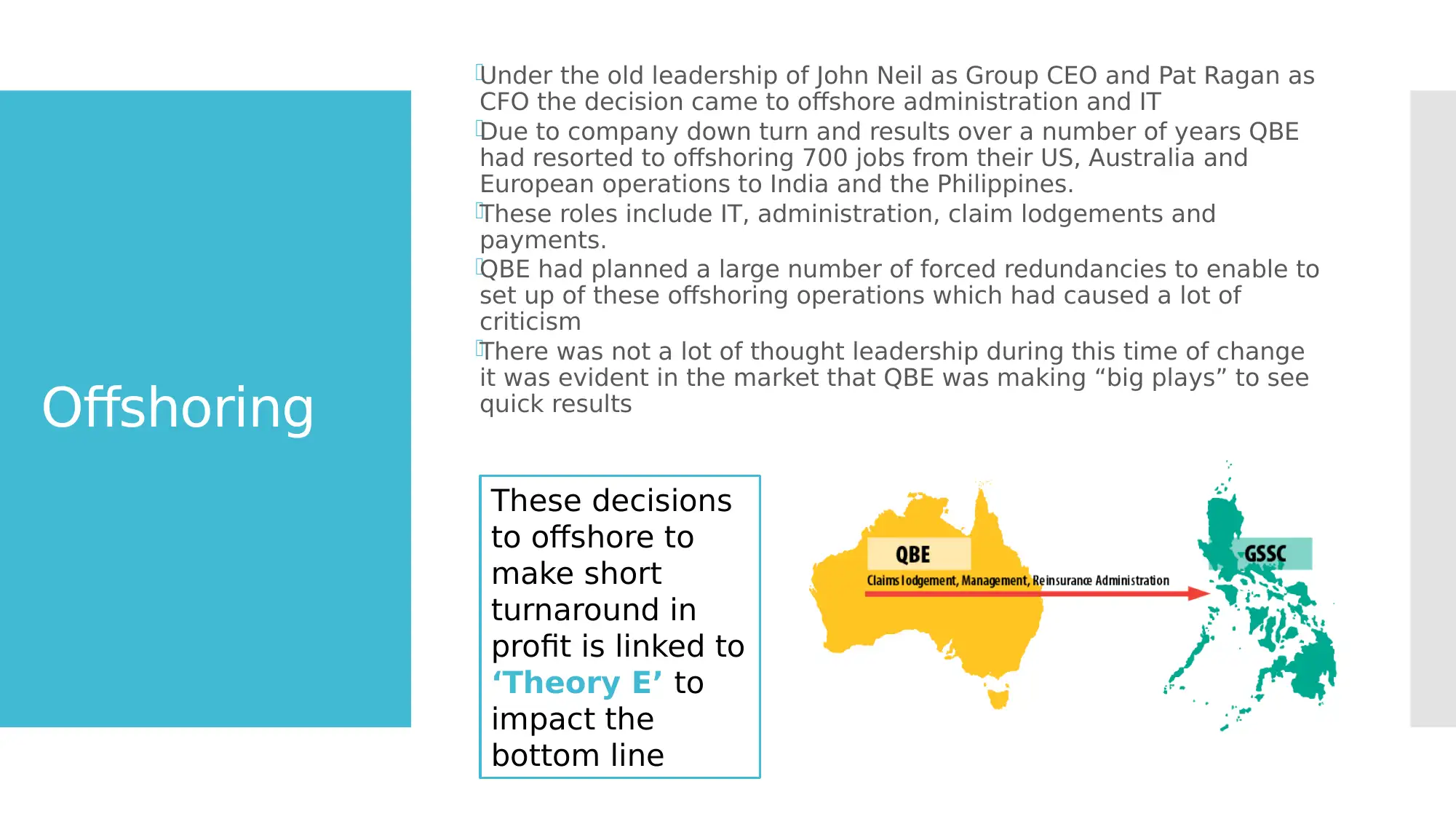
Offshoring
Under the old leadership of John Neil as Group CEO and Pat Ragan as
CFO the decision came to offshore administration and IT
Due to company down turn and results over a number of years QBE
had resorted to offshoring 700 jobs from their US, Australia and
European operations to India and the Philippines.
These roles include IT, administration, claim lodgements and
payments.
QBE had planned a large number of forced redundancies to enable to
set up of these offshoring operations which had caused a lot of
criticism
There was not a lot of thought leadership during this time of change
it was evident in the market that QBE was making “big plays” to see
quick results
These decisions
to offshore to
make short
turnaround in
profit is linked to
‘Theory E’ to
impact the
bottom line
Under the old leadership of John Neil as Group CEO and Pat Ragan as
CFO the decision came to offshore administration and IT
Due to company down turn and results over a number of years QBE
had resorted to offshoring 700 jobs from their US, Australia and
European operations to India and the Philippines.
These roles include IT, administration, claim lodgements and
payments.
QBE had planned a large number of forced redundancies to enable to
set up of these offshoring operations which had caused a lot of
criticism
There was not a lot of thought leadership during this time of change
it was evident in the market that QBE was making “big plays” to see
quick results
These decisions
to offshore to
make short
turnaround in
profit is linked to
‘Theory E’ to
impact the
bottom line
Paraphrase This Document
Need a fresh take? Get an instant paraphrase of this document with our AI Paraphraser
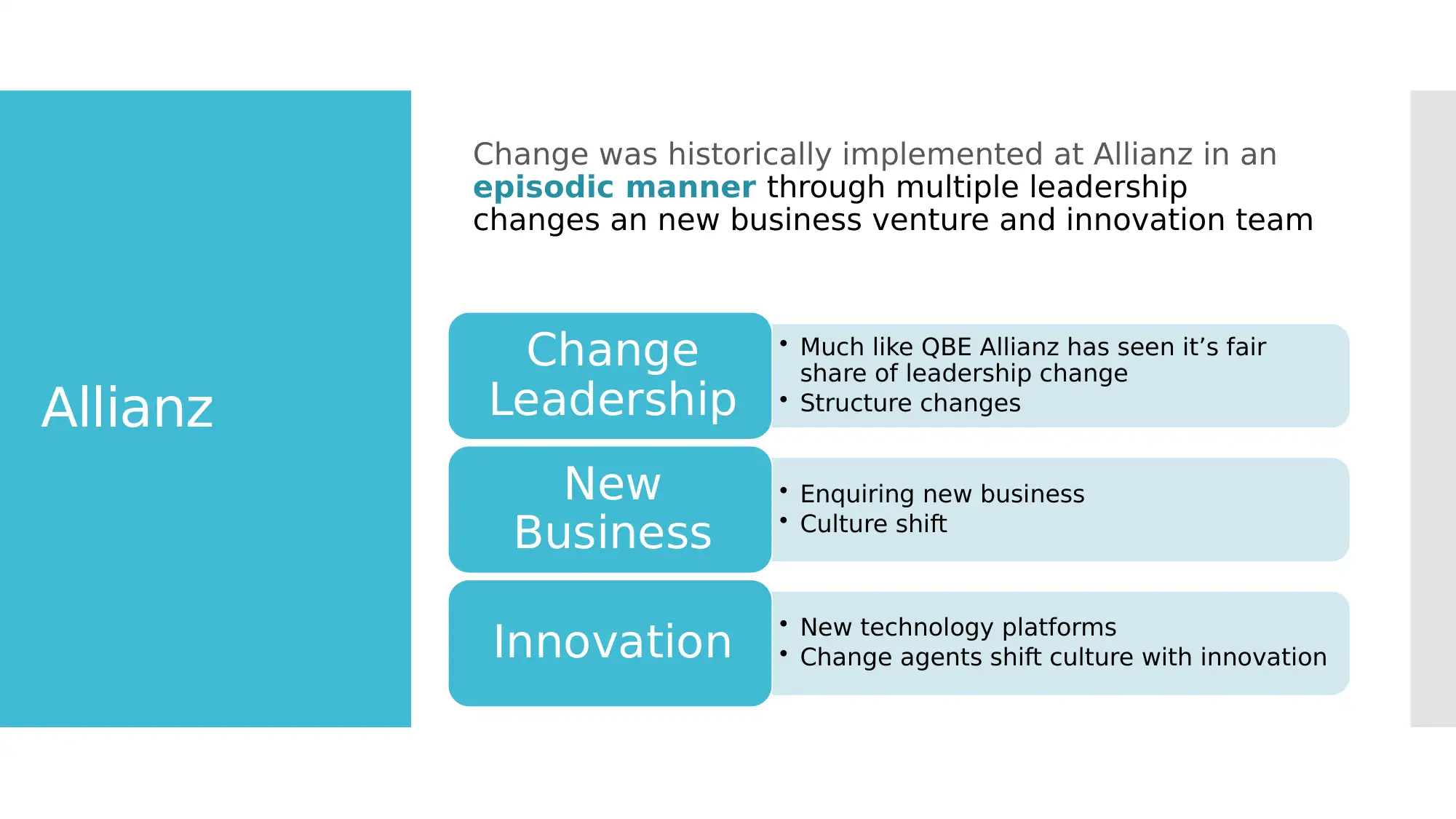
Allianz
Change was historically implemented at Allianz in an
episodic manner through multiple leadership
changes an new business venture and innovation team
• Much like QBE Allianz has seen it’s fair
share of leadership change
• Structure changes
Change
Leadership
• Enquiring new business
• Culture shift
New
Business
• New technology platforms
• Change agents shift culture with innovationInnovation
Change was historically implemented at Allianz in an
episodic manner through multiple leadership
changes an new business venture and innovation team
• Much like QBE Allianz has seen it’s fair
share of leadership change
• Structure changes
Change
Leadership
• Enquiring new business
• Culture shift
New
Business
• New technology platforms
• Change agents shift culture with innovationInnovation
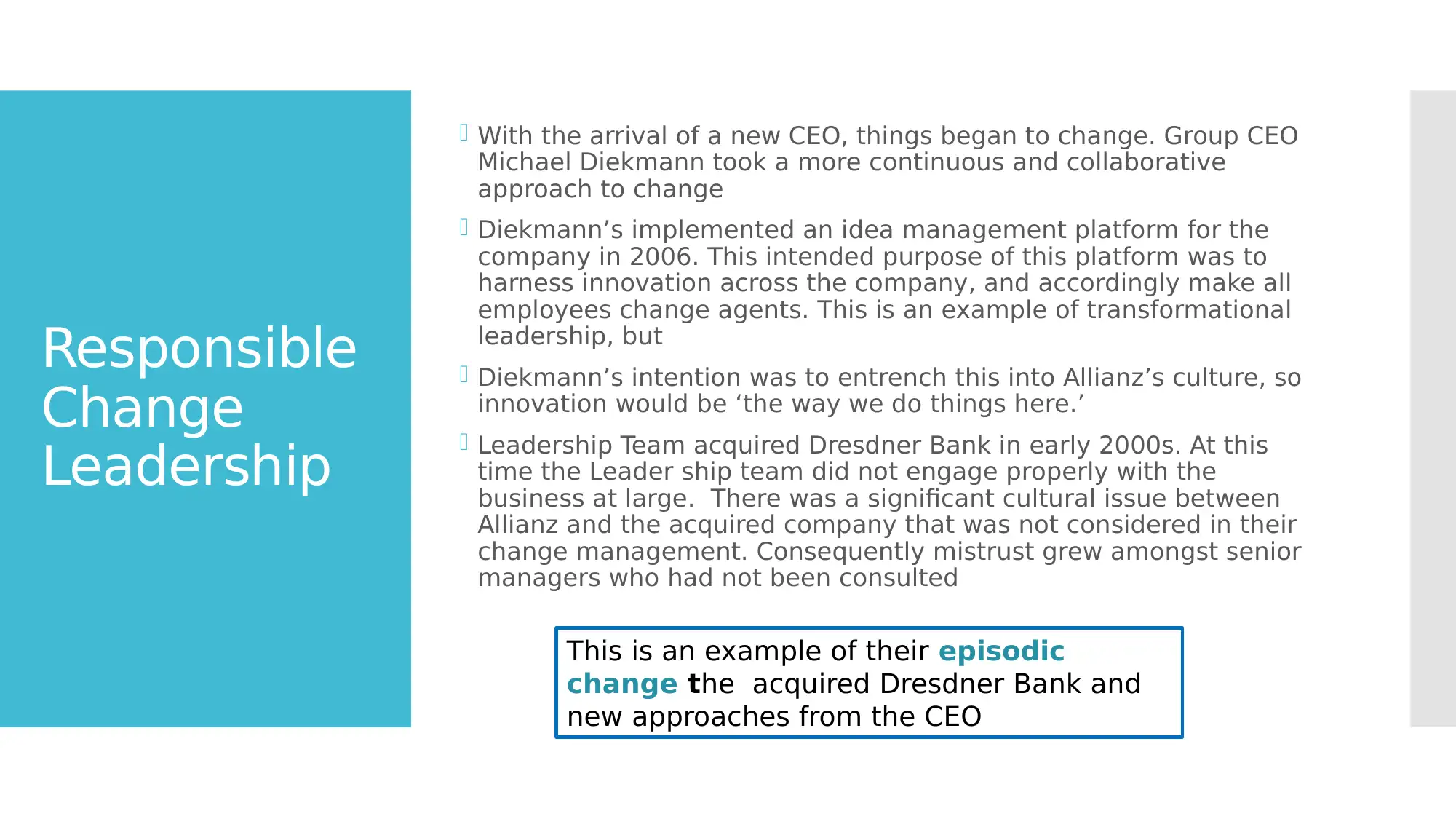
Responsible
Change
Leadership
With the arrival of a new CEO, things began to change. Group CEO
Michael Diekmann took a more continuous and collaborative
approach to change
Diekmann’s implemented an idea management platform for the
company in 2006. This intended purpose of this platform was to
harness innovation across the company, and accordingly make all
employees change agents. This is an example of transformational
leadership, but
Diekmann’s intention was to entrench this into Allianz’s culture, so
innovation would be ‘the way we do things here.’
Leadership Team acquired Dresdner Bank in early 2000s. At this
time the Leader ship team did not engage properly with the
business at large. There was a significant cultural issue between
Allianz and the acquired company that was not considered in their
change management. Consequently mistrust grew amongst senior
managers who had not been consulted
This is an example of their episodic
change the acquired Dresdner Bank and
new approaches from the CEO
Change
Leadership
With the arrival of a new CEO, things began to change. Group CEO
Michael Diekmann took a more continuous and collaborative
approach to change
Diekmann’s implemented an idea management platform for the
company in 2006. This intended purpose of this platform was to
harness innovation across the company, and accordingly make all
employees change agents. This is an example of transformational
leadership, but
Diekmann’s intention was to entrench this into Allianz’s culture, so
innovation would be ‘the way we do things here.’
Leadership Team acquired Dresdner Bank in early 2000s. At this
time the Leader ship team did not engage properly with the
business at large. There was a significant cultural issue between
Allianz and the acquired company that was not considered in their
change management. Consequently mistrust grew amongst senior
managers who had not been consulted
This is an example of their episodic
change the acquired Dresdner Bank and
new approaches from the CEO
⊘ This is a preview!⊘
Do you want full access?
Subscribe today to unlock all pages.

Trusted by 1+ million students worldwide
1 out of 16
Related Documents
Your All-in-One AI-Powered Toolkit for Academic Success.
+13062052269
info@desklib.com
Available 24*7 on WhatsApp / Email
![[object Object]](/_next/static/media/star-bottom.7253800d.svg)
Unlock your academic potential
Copyright © 2020–2025 A2Z Services. All Rights Reserved. Developed and managed by ZUCOL.





